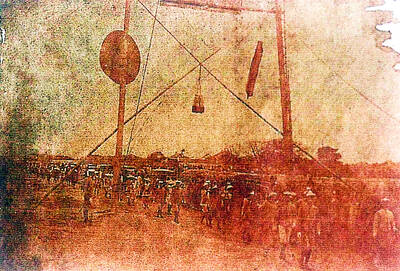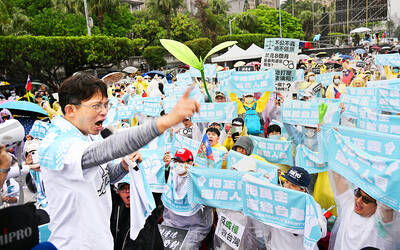A new gezai opera by the Hsu Ya-fen Opera Company (許亞芬歌子劇坊) titled Dharma Master Wu-Da’s Penance (慈悲三昧水懺) premieres today at the Metropolitan Hall (城市舞台) in Taipei City. While Buddhist themes are not unusual in gezai opera, Hsu Ya-fen (許亞芬), the company founder and star of the new opera, has taken the unusual step of taking monastic vows, albeit temporarily, to better enter into the spirit of her role as Dharma Master Wu-Da (悟達國師).
The opera tells the story of the monk Wu-Da who as a humble aesthetic shows great compassion for those around him, but after finding favor with the emperor becomes arrogant and overbearing. Supernatural forces of retribution cause him to develop a terrible sore on his knee; this sore is able to speak and tells him of an evil deed committed in a past life, retribution for which had only been averted until this time due to his goodness. Eventually, Dharma Master Wu-Da pacifies this apparition and finds redemption from his sins both past and present. He writes down the story of his arrogance and salvation as penance. The story takes place during the Tang Dynasty, the apogee of Buddhist development in China.
In an interview with Taipei Times, Hsu said she had consulted with many monastics in preparing this opera, in the course of which she decided that she wanted to fully engage with her role by the taking of monastic vows for the duration of the rehearsals and performances.
Hsu said her decision to take monastic vows, although temporary, had made it easier for her to understand the lives and attitudes of the monk she portrays, and made a real connection with the religious ideas that the original story of Dharma Master Wu-Da’s Penance represents. “The nature of the story is such that it can only be realized if the time and the motivation are right,” Hsu said. Although not originally a devout Buddhist, Hsu added that the performance had faced many difficulties in production, and it was her newly found commitment to Buddhist practices and ideas that had helped her work through them. “It has been a very educational experience,” she said.
Hsu, who comes from a theatrical family, has been a gezai opera performer for two decades. She opened her own company two years ago and aims to extend the range of her performances to incorporate other performance styles. With Dharma Master Wu-Da’s Penance, she has already incorporated elements taken from Beijing opera and also some aspects of traditional Chinese dance.
The participation of the Fo Guang Shan (佛光山) Buddhist organization has allowed this performance to grow into a major production, with more than 30 performers and the support of the Fo Guang Choir (佛光山合唱團) and the Fo Guang Dun Hang Dance Troupe (人間敦煌舞藝團). “The Buddhist chanting and so on fit quite well with gezai opera in musical terms, but we also needed to make sure the whole thing does not become too solemn,” Hsu said.
Her company started out doing public service gezai operas against the dangers of drug use and government corruption, which proved enormously successful with young audiences. Gezia opera, as with much traditional Chinese opera, has always had a strong moral dimension, so this move merely brings some of the issues up to date.
In addition to pushing beyond the conventional limits of Chinese opera in terms of performance, Hsu said that the company maintains a very active online presence with a blog and comments board. “Many young people write to reflect on what they have seen,” she said. “Theater is a reflection on life, and to make people think about ways of living is really what we are all about.”

June 23 to June 29 After capturing the walled city of Hsinchu on June 22, 1895, the Japanese hoped to quickly push south and seize control of Taiwan’s entire west coast — but their advance was stalled for more than a month. Not only did local Hakka fighters continue to cause them headaches, resistance forces even attempted to retake the city three times. “We had planned to occupy Anping (Tainan) and Takao (Kaohsiung) as soon as possible, but ever since we took Hsinchu, nearby bandits proclaiming to be ‘righteous people’ (義民) have been destroying train tracks and electrical cables, and gathering in villages

Dr. Y. Tony Yang, Associate Dean of Health Policy and Population Science at George Washington University, argued last week in a piece for the Taipei Times about former president Ma Ying-jeou (馬英九) leading a student delegation to the People’s Republic of China (PRC) that, “The real question is not whether Ma’s visit helps or hurts Taiwan — it is why Taiwan lacks a sophisticated, multi-track approach to one of the most complex geopolitical relationships in the world” (“Ma’s Visit, DPP’s Blind Spot,” June 18, page 8). Yang contends that the Democratic Progressive Party (DPP) has a blind spot: “By treating any

Swooping low over the banks of a Nile River tributary, an aid flight run by retired American military officers released a stream of food-stuffed sacks over a town emptied by fighting in South Sudan, a country wracked by conflict. Last week’s air drop was the latest in a controversial development — private contracting firms led by former US intelligence officers and military veterans delivering aid to some of the world’s deadliest conflict zones, in operations organized with governments that are combatants in the conflicts. The moves are roiling the global aid community, which warns of a more militarized, politicized and profit-seeking trend

This year will go down in the history books. Taiwan faces enormous turmoil and uncertainty in the coming months. Which political parties are in a good position to handle big changes? All of the main parties are beset with challenges. Taking stock, this column examined the Taiwan People’s Party (TPP) (“Huang Kuo-chang’s choking the life out of the TPP,” May 28, page 12), the Democratic Progressive Party (DPP) (“Challenges amid choppy waters for the DPP,” June 14, page 12) and the Chinese Nationalist Party (KMT) (“KMT struggles to seize opportunities as ‘interesting times’ loom,” June 20, page 11). Times like these can